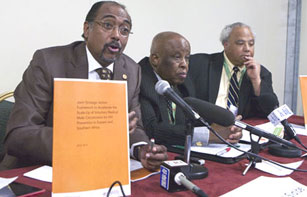
Press Release
International partners call for accelerated access to voluntary medical male circumcision in eastern and southern Africa
05 December 2011 05 December 2011
From left to right: UNAIDS Executive Director Michel Sidibé, former president of Botswana, Mr Festus Gontebanye Mogae, Ambassador Eric Goosby, United States Global AIDS Coordinator call for accelerated access to voluntary medical male circumcision in eastern and southern Africa, at ICASA 2011. 5 December 2011.
Credit: UNAIDS/ P. Wiggers
ADDIS ABABA, 5 December 2011—The Joint United Nations Programme on HIV/AIDS (UNAIDS) and the U.S. President’s Emergency Plan for AIDS Relief (PEPFAR) today launched a five-year action framework to accelerate the scale-up of voluntary medical male circumcision (VMMC) for HIV prevention. The framework—developed by the World Health Organization (WHO), UNAIDS, PEFPAR, the Bill & Melinda Gates Foundation and the World Bank in consultation with national Ministries of Health—calls for the immediate roll-out and expansion of VMMC services in 14 priority countries of eastern and southern Africa.
“Voluntary medical male circumcision is a high-impact and cost-effective prevention tool that will bring us one step closer to our goal of an HIV-free generation," said UNAIDS Executive Director Michel Sidibé, who unveiled the action framework at the 16th International Conference on AIDS and STIs in Africa (ICASA), together with partners. “Each HIV infection averted is money in the bank and fiscal space for the future,” he added. Joining Mr Sidibé at the launch in Addis Ababa, Ethiopia, were the U.S. Global AIDS Coordinator Dr Eric Goosby and the former President of Botswana, Festus Mogae.
There is compelling evidence that VMMC, when provided by well-trained health professionals, reduces the risk of sexual transmission of HIV from women to men by approximately 60 per cent. Since 2007, WHO and UNAIDS have urged countries with high HIV prevalence and low levels of male circumcision to expand access to safe VMMC services.
VMMC offers excellent value for money. Recent modelling commissioned by PEPFAR and UNAIDS found that reaching 80% coverage of adult VMMC in the 14 priority countries would entail performing approximately 20 million circumcisions on men aged 15-49 by the year 2015. Such a scale-up would cost a total of US$1.5 billion and would result in a net savings of US$16.5 billion by 2025 due to averted treatment and care costs. An estimated 3.4 million new HIV infections would be averted through 2025.
To date, the scale-up of VMMC has been modest in most countries. According to the joint framework, more than 550 000 men aged 15-49 had been circumcised in the 14 priority countries by the end of 2010. The greatest success in scaling up adult VMMC has occurred in Kenya, particularly in Nyanza Province. While progress in implementing VMMC programmes has been more limited in the other priority countries, nearly all countries saw the pace of scale-up quicken in 2010.
Acknowledging the important role of country ownership and accountability in health systems, U.S. Global AIDS Ambassador Dr Eric Goosby stated, “PEPFAR strongly supports heightened and immediate national ownership in all priority countries to implement safe, efficient voluntary medical male circumcision scale-up strategies. VMMC offers men an unprecedented opportunity to assume a proactive role in reducing their risk of contracting HIV, empowering them to protect their health and the health of their partners."
The new framework proposes strategic and coordinated action among partners at local, national and global levels to harness resources and focus on reaching adult and adolescent men with VMMC services as quickly and safely as possible. It underscores that country leadership is critical to the success and sustainability of this initial phase of VMMC programmes. The longer-term goal is to offer VMMC for all infants in the priority countries—replacing the need for adolescent and adult VMMC.
Innovation in service delivery, supply chain logistics, human resource deployment and medical devices is encouraged to improve efficiency, access, and safety, while creating demand for VMMC services. The framework urges governments in the 14 priority countries to seek funding from a range of domestic and international sources—with a view, over time, to a greater reliance on national on and local resources.
Speaking at today’s press briefing, Mr Festus Mogae called on leaders to support and scale up VMMC programmes in the 14 priority countries. “Strong collaboration between political, traditional and religious leadership will be critical to the safe and effective scale up of VMMC services,” said Mr Mogae, who is the chairman of Champions for an HIV-Free Generation, a non-governmental organization. “The key role of religious and traditional leaders is to ensure that there is a working partnership with the communities so that while the circumcision is done medically as an add-on HIV prevention strategy, it still retains its religious or cultural significance to the communities,” he added.
VMMC is an important component of a comprehensive HIV prevention package. WHO, UNAIDS and PEPFAR recommend a combination approach to HIV prevention that includes the correct and consistent use of male and female condoms; treatment for sexually transmitted infections; the promotion of safer sexual practices such as avoidance of penetrative sex; the provision of antiretroviral therapy for HIV-positive people who are eligible for treatment; and voluntary medical male circumcision in certain settings.
VMMC is a life-saving HIV intervention with major cost benefits. A one-time health intervention, VMMC confers life-long partial protection against HIV. The joint framework launched today embraces urgent and widespread scale-up of VMMC in all priority countries through a coordinated, country-driven effort.
Contact
UNAIDS GenevaSaira Stewart
tel. +41 79 467 2013
stewarts@unaids.org
PEPFAR
Kate Glantz
tel. +1 202 663 2952
glantzke@state.gov
Press centre
Download the printable version (PDF)
